Soybean Seeding Rate Considerations

Crop Insights
Written by Mark Jeschke, Ph.D., Agronomy Manager
Crop Insights
Written by Mark Jeschke, Ph.D., Agronomy Manager
The number of seeds to plant per acre is a decision that crop producers must make each year and is important for maximizing yield potential of the crop. In general, the objective is to plant seeds at sufficient density to maximize light capture and yield potential but avoid planting more seeds than necessary, which would incur additional seed cost and could potentially have a detrimental effect on the crop due to increased competition among the plants for resources.
Seeding rates are often targeted toward an agronomic or economic optimum. The agronomically optimum seeding rate is the minimum seeding rate necessary to maximize yield potential. The economically optimum seeding rate is the seeding rate at which economic return is maximized. The economic optimum is always slightly less than the agronomic optimum and varies depending on seed cost and grain price.
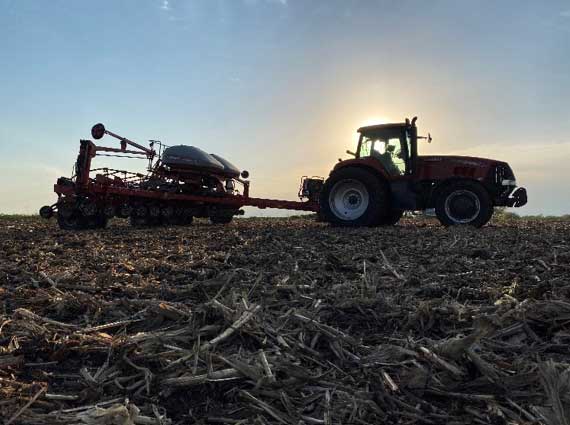
Soybeans are generally less affected by seeding rate than some other crop species such as corn due to the inherent adaptability of the plant. The ability of soybean plants to increase their lateral branching in low density environments give them some capacity to compensate for poor stand establishment. Soybeans also generally experience some degree of natural plant attrition during the growing season, which greatly reduces any potential risk of reduced yield and agronomic performance associated with high plant density.
Historically, the relatively low sensitivity of soybeans to plant density coupled with low seed cost meant that optimizing seeding rates in soybeans was not particularly critical. As a result, seeding rate practices varied widely across different environments and agronomic practices. Increasing soybean seeding rates in more stressful environments provided cheap insurance against poor stand establishment. Seeding rates in excess of 200,000 seeds/acre were not uncommon for soybeans planted with a drill in no-till systems.
A number of factors in recent years have reduced the need for elevated seeding rates to guard against poor stand establishment as well as increased the incentive to bring seeding rates into closer alignment with economic optimums. Consequently, average seeding rates for soybeans have steadily declined over the past couple of decades and have become more uniform across geographies.
As seeding rates have declined, the risk of reduced yield associated with poor stand establishment has become more of an issue. At the same time, recent research has shown a greater yield benefit to early soybean planting (Van Roekel, 2019), making it important to ensure adequate stand establishment upon initial planting, especially in more stressful early-season conditions, and avoid the need for replant.
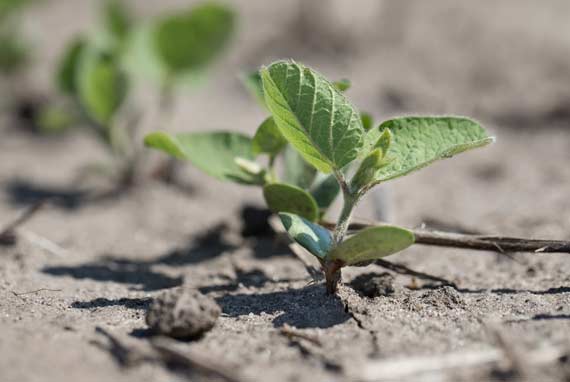
Soybeans differ from corn in some important ways with regards to seeding rate response and trends in grower practices over time. Seeding rates in corn have steadily increased over time, with agronomic optimum rates increasing from around 30,000 plants/acre 35 years ago, to over 37,000 plants/acre today (Assefa et al., 2018). Greater plant density has been the primary driver of corn yield gain over time, as breeding has improved stress tolerance in corn and the ability of plants to produce consistent ears at higher plant densities.
Soybeans, however, do not have the same degree of correlation between plant density and yield. Historically soybeans were often seeded at rates well over 200,000 seeds/acre. However, since the turn of the current century, seeding rates have steadily declined to an average of around 147,000 seeds/acre in 2022 (Corteva Agriscience Grower Survey) even as soybean yields have continued to increase. There are several factors that have contributed to these divergent trends:
Breeding for greater yield per plant. Research on genetic gain in soybeans has shown that newer soybean varieties have a greater ability to compensate for low plant density by producing more yield on the branches of the plants (Suhre et al., 2014). This has reduced the yield penalty risk associated with sub-optimal plant density.
Higher seed cost. Soybean seed cost per acre has nearly doubled since 1997 (accounting for inflation) with the increased yield potential and herbicide tolerance traits of modern varieties (USDA-ERS, 2023). This higher cost has created a greater incentive to optimize soybean seeding rates for economic return.
Improved planting accuracy. Historically, a substantial portion of soybean acres were planted with drills, which made higher seeding rates necessary to compensate for the relatively low accuracy of seed placement. However, the trend away from planting soybeans with drills in favor of row crop planters and improved seed placement with newer precision drills has reduced this need (Jeschke and Lutt, 2016).
Adoption of seed treatments. Advances in seed treatments and their widespread adoption by growers have increased the resilience of soybeans against stressful conditions after planting, reducing the need to use higher seeding rates to protect against poor stand establishment. Pioneer field studies conducted in the early-2000s showed that fungicide + insecticide seed treatments improved soybean stand establishment with early planting compared to non-treated seed and reduced the economically optimum seeding rate by an average of 5% with normal planting dates and 14% with early planting dates (Trybom et al., 2009; Trybom, 2009).
Herbicide tolerance traits. The widespread adoption of soybean varieties with herbicide tolerance traits beginning in the 1990s allowed for more effective post-emergence weed control in soybeans, reducing the need to rely on higher soybean density as a cultural tool for suppressing weed growth.
Another important difference between soybean and corn seeding rate response is the effect of yield environment on optimum plant density. The optimum plant density for corn generally increases as productivity increases. Recent Corteva Agriscience plant population research showed that the economic optimum seeding rate increased from approximately 30,000 seeds/acre at a yield level of 150 bu/acre to around 37,000 seeds/acre at a yield level of 240 bu/acre (Jeschke, 2019). Research in soybeans, however, has shown the opposite trend. A recent analysis of over 200 soybean seeding rate studies in the U.S. and Canada showed that soybean producers should increase seeding rates in areas of lower productivity and decrease seeding rates in areas of higher productivity (Gaspar, 2019).
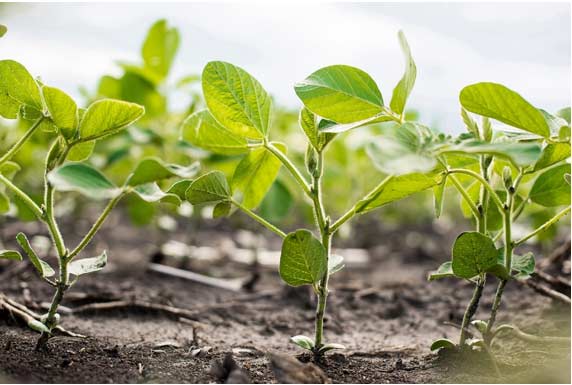
One hypothesis for why this relationship has been observed has been that areas of low productivity have lower initial stand establishment and/or greater plant attrition over the course of the growing season, resulting in a lower harvest stand. However, research has found that stand establishment is not generally affected by yield level, regardless of geographical location in the U.S. Likewise, plant attrition during the growing season does not appear to differ according to yield level (Gaspar, 2019).
The need for higher soybean seeding rates in lower productivity environments is primarily due to limitations on plant growth rate and branching. Plant growth can be limited due to many factors, such as precipitation, soil water-holding capacity, nutrient supply, rooting depth, etc. These factors, most commonly limiting in low productivity areas, can challenge the ability of soybean plants to maximize season-long light interception. Increased plant density is therefore required to maximize light interception and yield in these lower productivity environments.
Soybean yield response to seeding rate has been studied in numerous field experiments over the years. Results of these studies have often varied widely. Some studies have determined that 100,000 plants/acre at harvest time are required to maximize light interception and thus yield (Gaspar and Conley, 2015; Lee et al., 2008) while other studies have shown economically optimal seeding rates ranging from 95,000 to 130,000 seeds/acre (Gaspar et al., 2017). However, these studies were often conducted in very uniform, well drained, and highly productive fields. Other field studies conducted in more stressful environments have suggested seeding rates as high as 243,000 plants/acre are needed to maximize soybean yield (Holshouser and Whittaker, 2002). Thus, there appears to be a wide range of agronomically and economically optimal seeding rates and plant stands that depend on seed costs, grain prices, seed treatment use, and –most importantly– the inherent productivity of the environment.
A recent study by Gaspar et al. (2020) pulled together data from a large number of soybean seeding rate field studies to quantify the production risk associated with soybean yield response to seeding rate and plant density from a range of environments across North America. Soybean seeding rate and yield data were compiled from 211 soybean seeding rate field experiments conducted across 12 U.S. states and Ontario, from 2005 to 2017. Cluster analysis was used to group field studies into similar growing environments based on GPS coordinates, soil characteristics, and weather variables. This analysis grouped research locations into three clusters with distinct latitudinal separation, with one cluster comprised of northern Corn Belt locations, one that covered many of the central Corn Belt and southern locations, and one between the two that partially overlapped both (Figure 1).
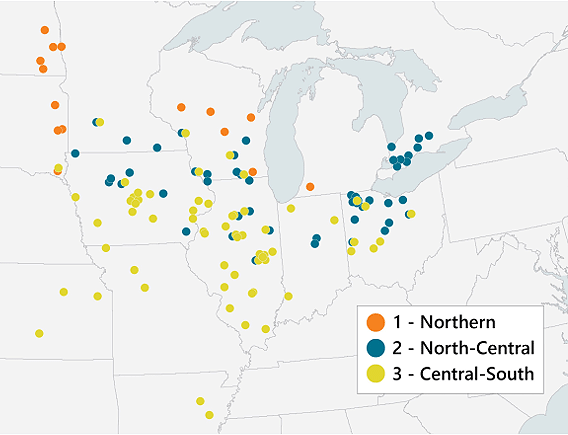
Figure 1. Locations of 211 trial site-years and environmental clusters of soybean seeding rate experiments analyzed by Gaspar et al. (2020).
Locations within each cluster were further subdivided into low, medium, and high yield groupings, comprised of the lowest 30%, the middle 30–70%, and the upper 30%, respectively (Table 1).
Table 1. Average soybean yield in high, medium, and low yield groupings by environmental cluster of soybean seeding rate experiments analyzed by Gaspar et al. (2020).
| Soybean Yield Level | |||
|---|---|---|---|
| Environmental Cluster | High | Medium | Low |
| ------ bu/a ------ | |||
| Northern | 81.7 | 67.6 | 46.1 |
| North-Central | 82.3 | 68.0 | 54.4 |
| Central-South | 81.9 | 70.3 | 55.1 |
Figure 2. Agronomically optimum seeding rates for low, medium, and high-yielding trial locations in the northern, north-central, and central-south environmental clusters in Gaspar et al. (2020)/ Click here or on the chart above for a larger image.
Although the yield level groupings spanned a wide yield range in all three environmental clusters, all yield level groupings were relatively high, reflecting the fact that field studies tend to be conducted in high productivity environments. For example, the low, medium, and high yield group averages for the Northern cluster were 46.1, 67.6, and 81.7 bu/acre, respectively. The average soybean yield as reported by USDA-NASS for the states represented in this cluster over the years of the study period was only 40 bu/acre.
Agronomically optimum seeding rates varied among environmental clusters and yield level groupings (Figure 2). Optimum seeding rates tended to be greater in more northern environments, as were the differences among yield levels. The Northern and North-Central clusters reflected findings of previous research that showed optimum seeding rates for soybean tended to increase in lower yielding environments. The Central-South cluster, however, did not exhibit this same trend. Optimum soybean seeding rate in this cluster increased with yield level but only slightly, with only 12,000 seeds/acre separating the high and low levels.
The difference in yield level trends between the Northern and North-Central clusters and the Central-South cluster may be attributable to the role of plant density in maximizing light capture. Soybean yield is linearly related to the cumulative amount of light captured during the R1 to R5 growth stages (Van Roekel and Purcell, 2016), a relationship that is stronger in more northern environments where seasonal photo-synthetically active radiation is more yield-limiting. In lower yield environments, where plant growth rate is more limited, higher plant density would be more important in maximizing light capture in northern locations.
An important consideration in soybean seeding rate decisions is the fact that the plant density of a stand of soybeans at the end of the season will often be considerably less than the number of seeds that went into the ground. Soybeans naturally undergo some amount of plant attrition during the growing season, so the number of plants per acre at the end of the season will not equal the number of plants that emerge. This is important when targeting a minimum final stand. The rate of attrition increases with plant density. Research has found that attrition rates of 10 to 20% are typical with current seeding rates. Assuming a 15% attrition rate, an initial plant stand of 120,000 plants/acre at V2 would result in a final stand of 102,000 plants/acre.
Germination and emergence rates must also be taken into account, as not all seeds that are planted will germinate and not all of those that germinate will successfully emerge. Modern soybean seed treatments have improved stand establishment rates by protecting germinating and emerging seedlings from soil-borne pathogens. However, abiotic factors such as soil crusting, crop residue, and imbibitional chilling can still impact emergence rates.
Figure 3 shows a scenario in which weather conditions following planting impacted soybean stand establishment at the Corteva Agriscience research center at Johnston, IA. The field experienced heavy rain after planting followed by an abrupt transition to hot and dry conditions, resulting in soil crusting. As the soil dried out, many later-emerging soybean seedlings were unable to pull their cotyledons free from the soil and snapped at the hypocotyl. Soybean stand loss was around 10%. The seeding rate in this field was 140,000 seeds/acre. Assuming a 90% germination rate and 10% plant attrition during the season, early season stand loss likely reduced final stand in this field to just above 100,000 plants/acre.
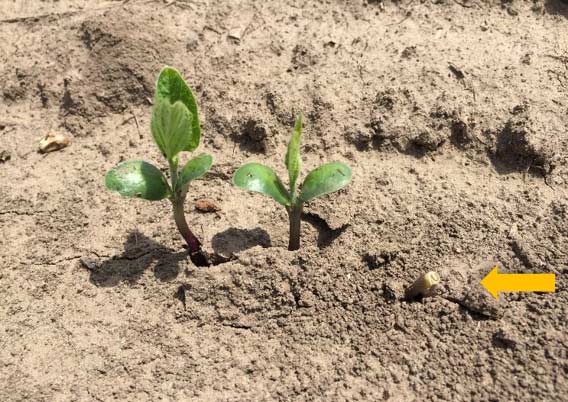
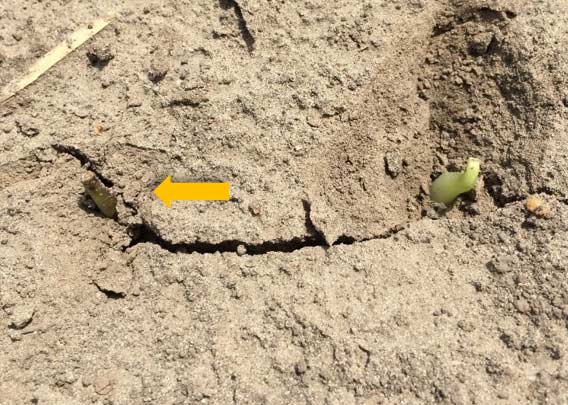
Figure 3. Emerging soybeans in dry, crusted soil at the Johnston Field Research Center in 2018, showing some seedlings that broke off during the emergence process.
| Normal Stand | Reduced Stand | |
|---|---|---|
| Seeding Rate | 140,000 | 140,000 |
| germination | 0.9 | 0.9 |
| Germinated | 126,000 | 126,000 |
| emergence | 1 | 0.9 |
| Emerged | 126,000 | 113,400 |
| attrition | 0.9 | 0.9 |
| Final Stand | 113,400 | 102,060 |
Soybean seeding rates should be high enough to provide some degree of protection against less-than-ideal conditions at emergence. Pushing seeding rates too low can increase the risk of needing to replant if everything does not go exactly right. Replanting soybeans can mean losing some of the higher yield potential with timely planting. Recent data suggest that modern soybean varieties have a greater yield response to earlier planting (Propheter and Jeschke, 2017; Van Roekel, 2019), making timely planting important to maximize yield potential (Figure 4). Earlier planting allows soybeans to take advantage of longer daylengths during mid-summer and can extend the duration of reproductive growth (Parker et al., 2016).
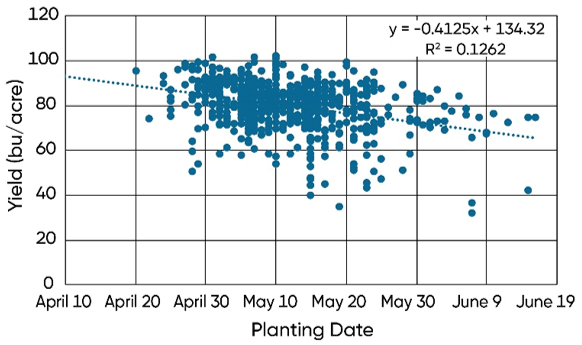
Figure 4. Soybean yield by planting date from four years of on-farm trials in Nebraska and Kansas (Propheter and Jeschke, 2017).
Weed management is becoming a more important consideration for soybean seeding rate and row spacing decisions in some cases. The ability of soybeans to suppress weed growth through canopy closure and reduced light transmission to the soil surface was historically an important consideration for both soybean seeding rate and row spacing. The denser the canopy and the earlier it closes the space between rows, the greater its ability to suppress weeds. The advent of herbicide resistance technologies, beginning with glyphosate-resistant soybeans in the mid-1990s, brought improved post-emergence weed control and reduced the need to rely on cultural practices to manage weed populations. However, the evolution and spread of glyphosate resistant populations of many weed species in subsequent years has reduced the effectiveness of chemical weed control and brought cultural practices back to the fore as important tactics to consider for managing weeds.
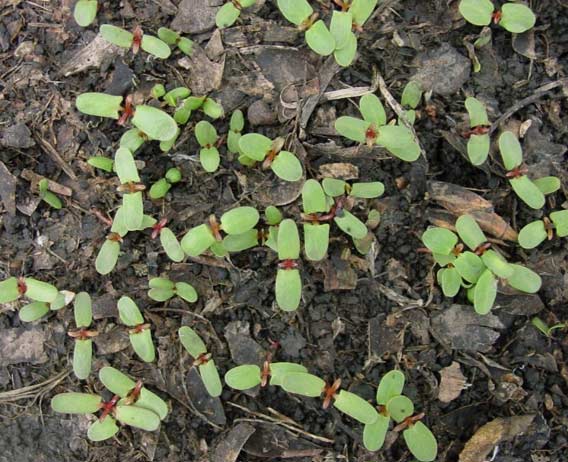
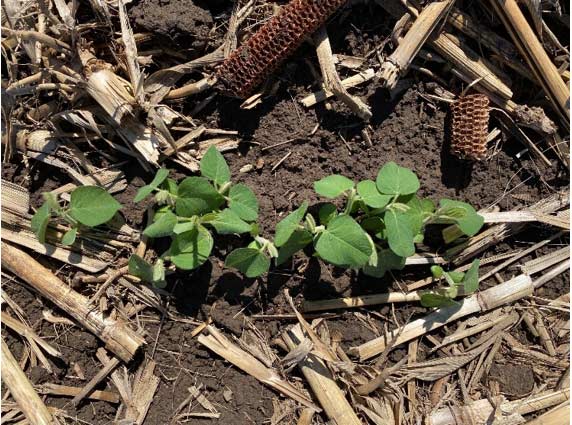
A field research study on the effects of soybean plant density on the growth of Palmer amaranth (Amaranthus palmeri) showed that plant density can have an important effect on weed growth and seed production. The study found that both biomass (Figure 5) and seed production (Figure 6) of Palmer amaranth increased as soybean density decreased. The impact of soybean plant density was greater the earlier the Palmer amaranth plants emerged relative to the crop.
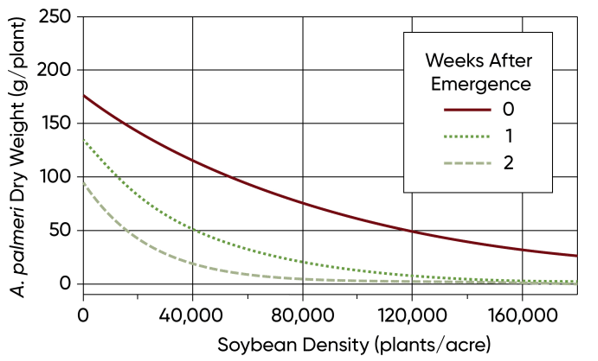
Figure 5. Effect of soybean density and Palmer amaranth emergence timing relative to the crop on Palmer amaranth dry weight per plant at harvest (Korres et al., 2020).
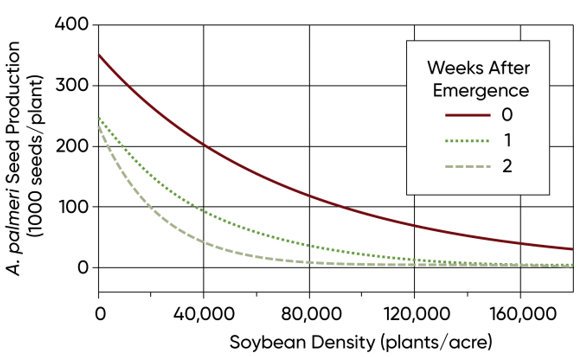
Figure 6. Effect of soybean density and Palmer amaranth emergence timing relative to the crop on Palmer amaranth seed production per plant at harvest (Korres et al., 2020).
Geographic region and yield level are the two most important factors to consider in soybean seeding rate decisions. However, several other factors may be important considerations in selecting a higher or lower seeding rate:
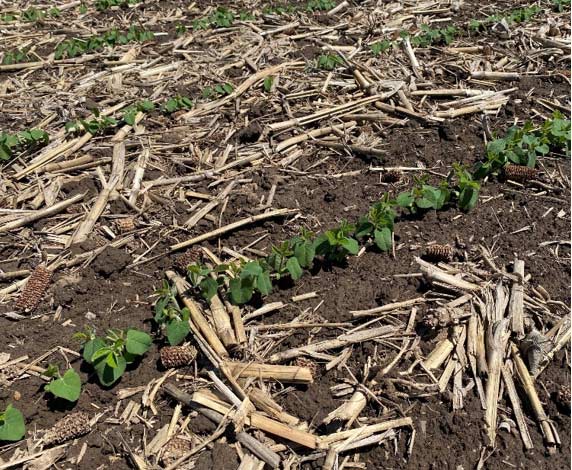
The foregoing is provided for informational use only. Please contact your Pioneer sales professional for information and suggestions specific to your operation. Product performance is variable and depends on many factors such as moisture and heat stress, soil type, management practices and environmental stress as well as disease and pest pressures. Individual results may vary. Pioneer® brand products are provided subject to the terms and conditions of purchase which are part of the labeling and purchase documents.